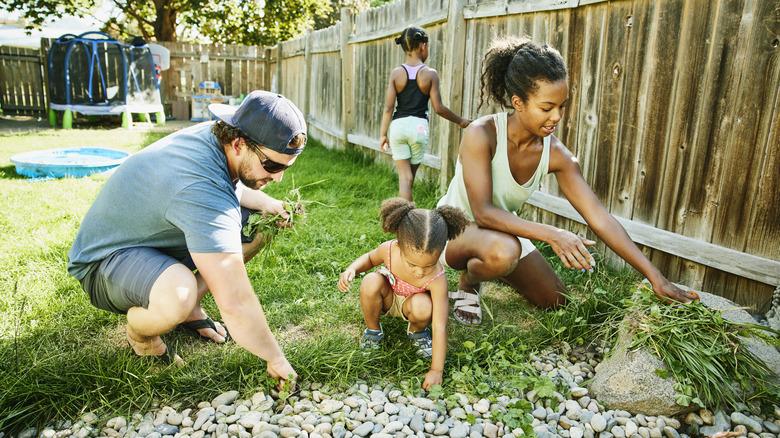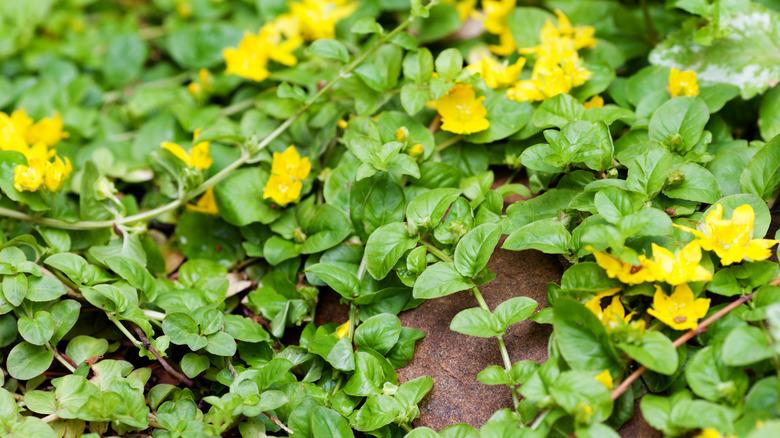The Best Way To Get Rid Of Weeds In The Garden Without Killing Other Plants
Wouldn't it be nice if there were a weed killer that could discriminate between plants you want to keep and plants you don't? That could do its weeding without harming insects, polluting waterways, lingering in the soil for decades, or ending up in our bloodstream? Well, there is. It's you. The most effective method of removing weeds without harming the plants you want to grow is to get down and dirty, pulling out the weeds by hand or with the help of a few garden tools.
Don't look at weeding as a chore but as an essential and rewarding part of a successful garden. "Gardening is an instrument of grace," as the poet Mary Sarton put it. "Everything that slows us down and forces patience, everything that sets us back into the slow circles of nature, is a help." You're outdoors and you're living in the moment, without a string trimmer, chemicals, or worries about what effect you're having on the environment.
Some essential weeding tools and tips will make the job easier. Weed a wet garden after it rains or after hosing it down so that the roots are easier to pull out. Get kneepads or a kneeler. Learn how to use a hand weeder, among other simple garden tools like trowels and weeding knives. Make weeding a regular habit: Ten minutes every other day is better than one weeding marathon. Know which weeds you can compost and which will just develop roots and regenerate in your compost pile. And to lessen your future weeding burden, lay down a fabric weed block and use mulch for weed control.
How to remove weeds that spread by seed
Weeds can spread by different methods. Each type requires a different method of weeding. Weeds that reproduce primarily by seeds are easier to control. Start early in the season, before the weeds have had a chance to produce seeds. A single purslane (Portulaca oleracea) plant can produce thousands of seeds, and the seeds of many weeds can remain viable in the soil for years. Remember: This year's seeds are next year's weeds.
Many weeds that spread by seed can be pulled out by hand. Crabgrass (Digitaria spp.) and orchard grass (Dactylis glomerata) are two common weed grasses that spread mostly by seeds, but they look like desirable lawn grasses. Learn your weed grass identification so you don't harm the grass you're trying to grow.
Other seed spreaders require a bit of digging. For example, dandelions (Taraxacum officinale) and Queen Anne's lace (Daucus carota) should be dug out. These weeds develop long taproots, allowing them to reach water at deeper levels. Other common weeds with taproots include bull thistle (Cirsium vulgare) and prostrate spurge (Euphorbia maculata). Be diligent: Fragments of weeds with taproots like purslane can remain in the soil and easily regenerate.
How to remove weeds that spread runners and roots
Weeds that spread primarily by runners (stolons), along the top of the soil, or by roots (rhizomes), below the soil surface, are harder to extract. Among the runners are many types of grasses, such as Bermuda grass (Cynodon dactylon) and creeping bentgrass (Agrostis stolonifera). Other "creepers" include creeping Jenny (Lysimachia nummularia) and creeping Charlie (Glechoma hederacea), both very difficult to eradicate once they're established. Weeds that spread by rhizomes can be even more difficult to remove. These include Canadian wild ginger (Asarum canadense), Japanese knotweed (Reynoutria japonica), and quackgrass (Elymus repens), all notorious weeds because they create widespread root systems that can crowd out other plants.
For controlling these weeds, start by removing all parts of the plant, including runners and roots. Follow the runners around your garden to make sure you get them all. Carefully follow the rhizomes underground. Roots and rhizomes can spread broadly and run very deep. They will continue to regenerate if you aren't able to fully remove them, so persistence is important. To kill these types of weeds permanently, you can also starve the plants of light by covering them with cardboard or tarps, or overwhelm them with light by solarizing them under clear plastic.
Alas, one of the primary characteristics of weeds is that they are better at reproducing than the plants that you do want in your garden. That's why diligence and persistence are the two most important attributes you can have in keeping the weeds at bay. If you don't have either of those qualities, it's time to call a professional.


